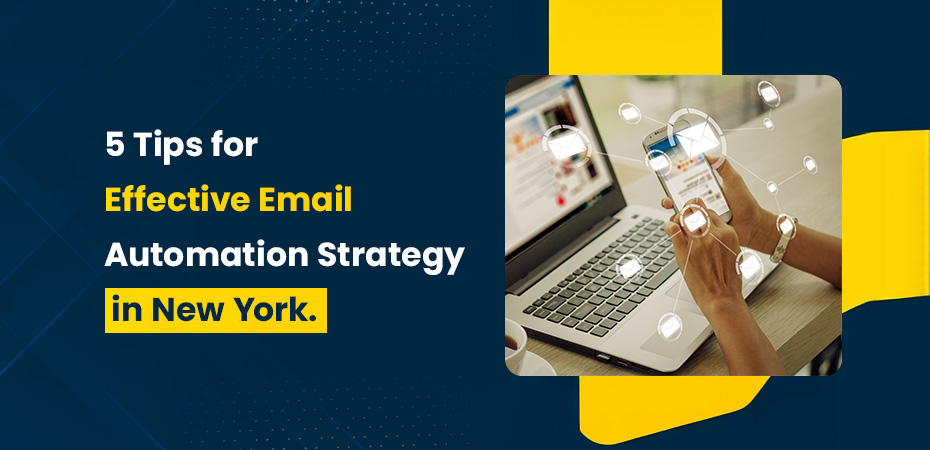5 Tips for Effective Email Automation Strategy in New York



The Impact of AI and Machine Learning on Email Marketing
Artificial Intelligence (AI) and Machine Learning have revolutionized digital marketing, and email marketing is no exception. These advanced technologies allow businesses to personalize emails like never before, making them more relevant and engaging for customers. By analyzing user behavior and preferences, AI helps marketers send the right message to the right audience at the right time.
Automation has also streamlined email marketing, reducing manual effort while improving efficiency. Businesses can now create automated email campaigns, segment audiences, and optimize email content automatically. This ensures that marketing efforts are not only consistent but also highly targeted.
Setting up a marketing automation strategy helps businesses build stronger customer relationships, boost engagement, and drive conversions. Personalized subject lines, dynamic content, and smart scheduling all contribute to better email performance. However, implementing marketing automation works best when combined with a strategic approach that includes human oversight and creativity.
With AI and automation continuing to evolve, businesses that invest in modern email marketing strategies will stay ahead of the competition. Adopting these technologies can lead to better customer experiences and long-term business growth.
Listed below are five email marketing automation best practices required to craft the best automated email campaigns:
1. Set Clear Goals
Set Clear Goals
Before starting an email automation strategy, define your goals. Without clear objectives, your emails may lack direction and fail to deliver results. Having a well-defined purpose will help you create targeted and effective campaigns that truly connect with your target audience.
- Decide what you want to achieve: Are you looking to increase website traffic, generate leads, or retain customers? Each goal requires a different approach. If you want to drive traffic, your emails should include engaging content and compelling calls to action. If lead generation is your focus, consider offering valuable resources like e-books or exclusive discounts. For customer retention, personalized follow-ups and special offers can help keep your audience engaged.
- Align your emails with your objectives: For example, welcome emails can introduce new subscribers to your business, while abandoned cart emails encourage customers to complete their purchases. Transactional emails, such as order confirmations or feedback requests, can enhance customer’s personal experience and build trust.
- Measure success: Keep track of your email performance to ensure your strategy is working and adjust as needed. Monitor key metrics such as open rates, click-through rates, and conversions. If certain emails are not performing well, make changes to improve engagement.
Having a clear purpose ensures your email campaigns stay focused and provide value to your audience.
2. Segment Your Audience
Segment Your Audience
Not all customers have the same interests, so sending identical emails to everyone won’t be effective. Audience segmentation allows you to send personalized emails that resonate with different groups. This approach ensures that your messages feel relevant and valuable to each subscriber.
- Group your audience: Divide your subscribers based on demographics, purchasing behavior, or interests. For example, customers who frequently purchase from a specific category can be grouped together, allowing you to send them highly targeted product recommendations. Similarly, segmenting based on location can help you send region-specific promotions or event invitations.
- Send relevant content: If a customer frequently buys a certain product, send recommendations based on their preferences. A customer who recently purchased a smartphone might be interested in accessories like cases or chargers. By delivering content that matches their needs, you increase the likelihood of engagement and conversion.
- Improve engagement: Personalized emails feel more relevant, leading to better open and click-through rates. Subscribers are more likely to engage with emails that speak directly to their interests, rather than receiving generic messages that don’t apply to them.
By understanding your audience and tailoring emails accordingly, you can make your automatic email marketing more impactful and meaningful, strengthening customer relationships and driving better results.
3. Focus on High-Quality Content
Focus on High-Quality Content
Great content is what keeps your audience interested. If your emails are dull or irrelevant, people won’t open them. To keep subscribers engaged, your content must be valuable, easy to read, and consistently delivered.
- Provide value: Make sure your emails offer useful information, special deals, or exciting updates. Subscribers appreciate content that benefits them, whether it’s a helpful guide, a discount on their favorite products, or early access to a new collection. Avoid sending emails just for the sake of it—each message should serve a purpose.
- Keep it simple and engaging: Use a friendly tone, short paragraphs, and visually appealing designs. Long, text-heavy emails can be overwhelming, so break up content with images, bullet points, and clear headings. A conversational approach makes your emails feel more personal and inviting.
- Be consistent: A well-planned email schedule keeps your audience engaged without overwhelming them. Sending too many emails can frustrate subscribers, while sending too few may cause them to lose interest. Find a balance that maintains regular communication without being intrusive.
Your emails should be a mix of educational, promotional, and engaging content that encourages subscribers to stay connected with your brand. By delivering high-quality, relevant messages, you can build stronger relationships and improve customer loyalty.
4. Use Automation to Save Time and Improve Engagement
Automate Key Emails for Efficiency
Email automation helps businesses stay in touch with customers without constant manual effort. By setting up automated emails, you can maintain consistent communication, save time, and ensure customers receive timely and relevant messages.
- Automate key messages. Set up welcome emails, abandoned cart reminders, and follow-up sequences. A welcome email can introduce new subscribers to your brand, while abandoned cart emails encourage customers to complete their purchase. Follow-up sequences, such as post-purchase emails or special offers, help keep customers engaged.
- Keep it human. Even though emails are automated, they should feel personal and natural. Use the recipient’s name, write in a conversational tone, and personalize content based on their behavior or interests. Avoid robotic or overly generic messages—customers should feel like they’re receiving a thoughtful message rather than an automated blast.
- Enhance customer relationships. Well-planned automation ensures customers receive timely and relevant emails, strengthening brand trust. When done right, automated emails make customers feel valued by offering useful information, recommendations, and exclusive deals.
For marketing automation, an email marketing strategy can help you maintain a consistent presence and nurture leads effortlessly. A well-structured email campaign automation strategy helps you stay connected with your audience while making your marketing more efficient and effective.
5. Monitor and Improve Your Strategy
Continuously Improve Your Email Strategy
Even with marketing, email automation requires continuous improvement. Regular monitoring and adjustments ensure your emails remain effective and relevant to your audience.
- Track performance. Monitor email open rates, click-through rates, and conversions to see what’s working. Keeping an eye on these metrics helps identify which emails are engaging and which need improvement. If open rates are low, your subject lines may need tweaking. If click-through rates are poor, your content or call-to-action may require adjustments.
- Make data-driven changes. Test different subject lines, email layouts, and call-to-action buttons to improve results. A/B testing allows you to compare variations of an email to see which performs better. Simple tweaks, such as changing the wording of a subject line or adjusting the placement of a button, can make a big difference in engagement.
- Stay updated. Email marketing trends and customer preferences change, so keep refining your approach. What works today may not be as effective in the future. Stay informed about industry best practices for campaign automation, experiment with new strategies, and listen to customer feedback to keep your emails fresh and impactful.
A successful and effective email marketing strategy in New York is one that adapts to the local customer behavior and continues to improve over time. By regularly evaluating and optimizing your automated email marketing campaigns, you can ensure lasting engagement and better results.
Tools for an Effective Email Automation Strategy
Using the right tools can streamline your email automation process, improve engagement, and drive better results. Here are some of the best email marketing automation software to assist you in developing a marketing automation (email) strategy:
- Email Marketing Platforms: Tools like Mailchimp, HubSpot, and ActiveCampaign help automate campaigns, segment audiences, and track performance.
- Customer Relationship Management (CRM) Software: Platforms such as Salesforce and Zoho CRM integrate with email marketing tools to personalize communication based on customer data.
- A/B Testing Tools: Services like Optimizely and Google Optimize allow you to test subject lines, content, and layouts to improve email effectiveness.
- Analytics & Reporting Tools: Google Analytics and built-in email marketing reports help measure key metrics like open rates, click-through rates, and conversions.
- Personalization & AI Tools: AI-powered solutions like Phrasee and Persado optimize email content and subject lines for better engagement.
Choosing the right combination of these email marketing automation tools ensures efficiency, personalization, and continuous optimization for a high-performing email automation strategy.
Conclusion
The best email marketing strategy starts with clear goals, smart audience segmentation, and valuable content. By combining these elements with data-driven decision-making, businesses can improve engagement and drive long-term success.
To stay ahead in a competitive market, brands must focus on innovation, adaptability, and a customer-first approach. Regularly refining, marketing your email strategies and embracing new trends will ensure sustained growth and higher returns.
For expert guidance on optimizing your email marketing efforts or seeking email automation services, connect with the specialists at SEO Expert New York. Take your marketing to the next level and achieve remarkable results.
Frequently Asked Questions (FAQs)
Email marketing automation refers to using software to automate email campaigns and sequences to target the right audiences with the right content at the right time. Automation involves scheduling emails based on user behaviors, preferences, and demographics, allowing for personalized communication that engages, nurtures, and converts potential customers into paying customers. Automation streamlines the communication process, increases efficiency, and improves overall marketing ROI by optimizing resource allocation and reducing manual effort required to manage email campaigns.
Audience segmentation involves dividing email subscribers into smaller groups based on specific criteria like purchase history, age, location, or interests. Segmenting your audience allows for more personalized email content, increasing relevance and engagement with your subscribers.
Tracking the right metrics is critical to evaluating the success of your email marketing campaigns. Common metrics include open rate, click-through rate (CTR), conversion rate, bounce rate, and unsubscribe rate. Open rate measures the percentage of recipients who opened your email, while CTR indicates how many clicked on a link within the email. Conversion rate reflects the effectiveness of your campaign in driving specific actions, such as making a purchase. Monitoring these metrics helps identify strengths and areas for improvement, driving continuous optimization and heightened overall performance.
A/B testing, or split testing, forms a comparative analysis of two email versions to discover which performs better. By testing elements like subject lines, call-to-action buttons, or content layout, marketers can determine what resonates with their audience. Continuous experimentation allows marketers to make data-driven decisions, enhancing recipient engagement and boosting campaign performance.
Mobile optimization ensures that emails are visually appealing and functional when viewed on mobile devices. Responsive email designs enhance readability and engagement, improving user experience and reducing bounce rates.